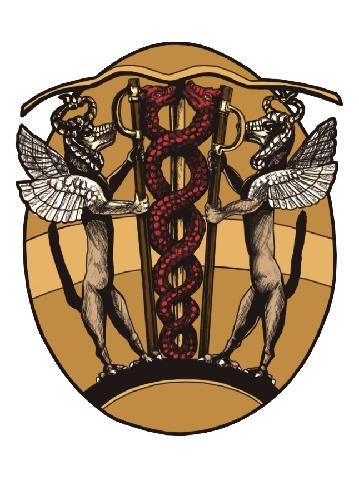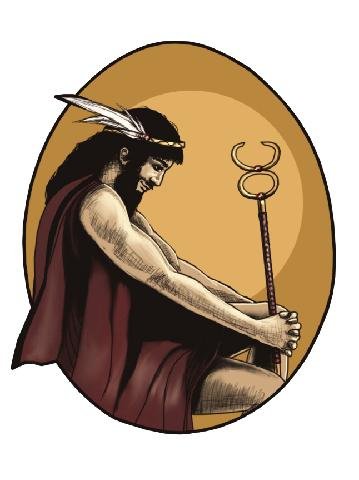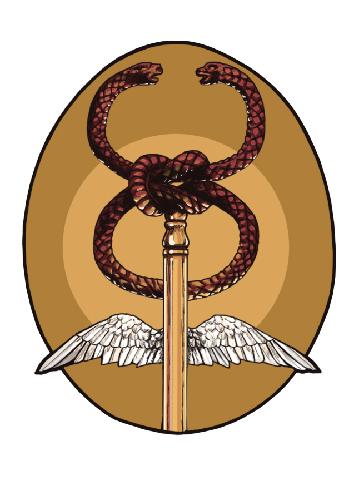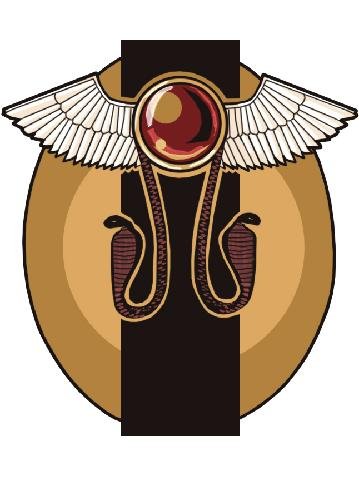Chemical Serpents: Caduceus

Images of a staff or wand with one or two serpents coiled about them date from thousands of years ago. The earliest example currently known to us dates from between 2200 and 2025 BCE in Mesopotamia, representations of the deity, Ningizzida. Depicted as two horned dragon-like snakes, probably 'bashmu' dragons, the animal sacred to Ningizzida. His name means 'Lord of the Good Tree', and he appeared as one of two guardians at the gates of Anu's celestial palace in Sumerian myth, yet strangely also one of the two guardians at the gate to the underworld.
In both cases the second guardian was Dumuzi, one time husband to the goddess Ishtar, the Queen of Heaven and Earth. Stephen Herbert Langdon notes that Dumuzi in one myth gets referred to as 'Ningizzida, the child Damu'. In another myth we find Ningizzida bound by a demon, taking him to the underworld, and his sister bargaining with the demon to lessen his burden. This reminds us of Geshtinanna who similarly intervenes when demons take her brother Dumuzi to the underworld.
In this myth, amongst other appellations, Ningizzida gets called Damu by his sister. Langdon also notes that both Ningizzida and Dumuzi bore the name, Ama-ushumgal-anna, which means Great Heavenly Mother Serpent. Ningizzida was associated with the constellation of Hydra, whilst Dumuzi, was associated with the constellation we know as Orion, but which the Sumerians called Sbzianna, the faithful shepherd of heaven. These stand either end of the Milky Way.
Without the staff, even older images of coiled serpopards, (serpents with the bodies of large cats), were found in both Mesopotamia and Egypt. An example in the Louvre, Paris, in the form of a cylinder seal from the Uruk period (between 4000 and 3000 BCE) shows the two cats facing each other with serpent necks coiled before their catlike heads face each other. In Egypt, the Narmer Palette from the 31st century BCE depicts two similar serpopards.

In Greek myth the messengers Iris and Hermes carried a staff known as the karykeion, which was topped with two serpents that coiled about each other once and faced each other, like the top of the Ningizzida image, or the necks of the serpopards.
The Roman version carried by Mercury, known as the caduceus, had two wings beneath the serpents and in time this image became simplified to a crescent atop a circle, like the zodiac sign for Taurus, and with the wings forming the cross bar became the symbol for the planet Mercury.

A form commonly found today, which is to say that of two serpents coiled about a staff, crowned with a winged disk, seems to combine elements of Ningizzida and the Roman caduceus with the solar disk of Heru-Behdeti. The latter a name of the Egyptian god Horus in the form of the solar disk, depicted with wings, and supported by two cobra serpents.

Hermes gave the Hermetic tradition its name, in the guise of Hermes Trismegistus, equated with the Egyptian god, Thoth. Mercury, as both god, metal and planet, also features strongly throughout the history of the tradition. Hermes and Mercury, in addition to their role as heavenly messengers, both also act as psycho-pomp, the guide of souls to the underworld, so like Ningizzida and Dumuzi have both Chthonic and Heavenly associations.
One use of the messenger staff was as a sign of peace or truce, and so the two snakes could represent two opposing forces uniting. This may echo the symbol of serpopards, which have also been said to represent the unification of two historical enemies, in the Narmer Palette the unification of Upper and Lower Egypt for example.
Some myths denote that Hermes obtained the karykeion from Apollo in exchange for a lyre he made from a tortoise shell. This apparently occurred when the two made peace after Hermes returned the cattle he stole from Apollo. However, in an another myth, Hermes came across two fighting serpents, and placed his wand between them. Obligingly they coiled up the wand and stopped fighting to become the karykeion. This version has a parallel in the myth of Merlin and his vision of the two fighting dragons.
Entwined snakes can also symbolise sexual union, as in 'The Marriage of Cadmus and Harmony', where Roberto Calasso describes two giant entwined snakes encountered by Zeus when he travels to the beginning of time after devouring Phanes.
"Space no longer existed. In its place was a convex surface clad with thousands upon thousands of scales. It extended beyond anything the eye could see. Looking downward along the scales, he realised that they were attached to other scales, the same colour, interwoven with them in knot after knot, each one tighter than the one before. The eye became confused, could no longer tell which of the two coiling bodies the scales belonged to. As he looked up again, towards the heads of the two knotted snakes, the body of the first snake rose, and its scales merged into something that no longer partook of the nature of a snake: it was the face of a god, the first face to reveal what a god's face was, and on either side of it were two other huge heads, one a lion and one a bull, while from the shoulders opened immense, airy wings. The white arm of a woman was twined to the arm of the god, just as below the tails of the two snakes were knotted together. The woman's face gazed steadily at the god's, while with her other arm, behind which trembled an immense wing, she stretched out toward the farthest extremity of everything: and where the tips of her fingernails reached, there Everything ended. They were a royal and motionless couple: they were Time-Without-Age and Ananke. "
Calasso refers to the god of time, Chronos, as Time-Without-Age alluding to the idea of eternity, who with his consort Ananke, begat Phanes.
In his book 'Living Midnight - Three movements of the Tao', Jan Fries describes an older form of Taijitu, the symbol for the yin and yang, which took the form a circle containing a black and white vortex, or double spiral. A double helix, the coiling form of two serpents, found in DNA, looked on from above would also appear as a double spiral. Some ancient North American images of rattle snakes have two serpents inside a circle, spiralling to face each other in the centre.
An ancient description of two serpents found in the Pyramid of Unas (24th Century BCE) reads:
“A serpent is entwined by a serpent, when a young hippopotamus coming on the pasture is entwined. Earth, swallow that which came out of you! Monster, lie down, glide away!”
This could refer to a caduceus type image, although a further passage later in the text reads:
“The male serpent is bitten by the female serpent, the female serpent is bitten by the male serpent. Heaven is enchanted, earth is enchanted, the male behind mankind is enchanted. Enchanted will be the god Blind-is-his-head. You, yourself, Scorpion, will be enchanted. These are the two knots of Elephantine which are in the mouth of Osiris (Unas), knotted for Horus over the backbone.”
The text fails to make clear whether the entwined serpents face each other or bite each others tails, but it suggests that they 'knot' or entwine about the backbone.
We also find the idea of serpents coiling about the spine in the Kundalini yoga of Tantric alchemy. C.W. Leadbeater compared the caduceus to the Kundalini serpent in 'The Chakras'.
_In India the spine is called the staff of Brahma. The archetype of the Caduceus, whose two serpents symbolise the Kundalini or serpent fire. _
An older 17th century Tantric illustration from the Basohli region of India also shows two serpents entwined in caduceus-like formation. These represent Ida and Pingala, subtle Lunar and Solar channels, or Nada, to the left and right of the central Kundalini channel, which passes more directly up the spine. The three channels meet at the Ajna chakra, located in the region of the eyebrows, and commonly known as the “third eye”.